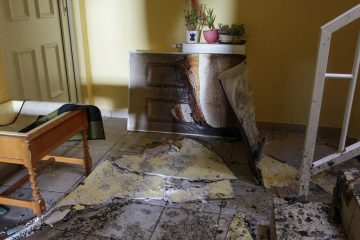Flooding can turn your life upside down in just a few hours. Beyond water damage to floors, walls, and furniture, the real danger often comes afterward—in the form of mold. For homeowners, knowing how to deal with mold in a flooded house is critical to protecting your health and restoring your home safely.
At Commando Restoration, we understand how quickly mold can spread after a flood. Within 24 to 48 hours, mold spores can begin to grow on wet surfaces. The longer moisture remains, the more difficult and expensive it becomes to remediate. This guide outlines key steps you should take as soon as floodwaters recede.
1. Prioritize Safety First
Before reentering your flooded home, make sure it’s safe. Shut off electricity and gas if flooding was significant. Wear protective gear including gloves, boots, and an N95 mask to reduce your exposure to airborne spores. If the structure has been compromised, wait for professional clearance before entering.
2. Start Drying Immediately
Time is your enemy when dealing with mold in a flooded house. The faster you can remove standing water and begin drying, the better your chances of preventing widespread contamination. Use wet/dry vacuums, dehumidifiers, and fans to dry out the space. Open all windows and doors to increase airflow and ventilation.
3. Remove and Discard Water-Damaged Items
Not everything can be saved. Porous materials like carpet, drywall, ceiling tiles, insulation, and mattresses often need to be discarded, as they retain moisture and are difficult to clean thoroughly. Furniture made of particle board, unsealed wood, or fabric should also be evaluated for mold risk. When in doubt, it’s safer to remove affected items to prevent mold spread.
4. Clean Non-Porous Surfaces Thoroughly
For items like plastic, glass, metal, or tile, clean them thoroughly with a non-ammonia soap or detergent. Then disinfect with a solution of 1 cup of bleach to 1 gallon of water. Never mix bleach with ammonia, as it produces toxic fumes. Scrub mold off hard surfaces and allow them to dry completely.
5. Watch for Hidden Moisture and Mold
Mold often hides in places you can’t see—inside walls, behind baseboards, under flooring, and inside HVAC systems. Just because a room looks dry doesn’t mean it’s mold-free. Infrared cameras and moisture meters, which professionals like Commando Restoration use, can help detect hidden moisture that could lead to mold outbreaks later.
6. Know When to Call in Professionals
If the flood affected more than one room, sat for more than 48 hours, or if you or a family member has respiratory issues, it’s best to call in a certified mold remediation company. Professionals not only remove existing mold but also use specialized equipment to dry and disinfect areas that homeowners might miss. They’ll also help ensure the home is safe before repairs and restoration begin.
7. Prevent Future Mold Growth
Once your home is dry and clean, take preventive measures to stop future mold growth:
- Install dehumidifiers in humid spaces
- Use mold-resistant drywall and insulation during repairs
- Seal basement walls and foundation cracks
- Clean gutters and downspouts to direct water away from the home
Mold prevention starts with moisture control. Being proactive about drying, sealing, and ventilating can make all the difference after flood damage.
Trust the Experts at Commando Restoration
Dealing with mold in a flooded house can be overwhelming, but you don’t have to handle it alone. Commando Restoration provides rapid-response mold remediation and water damage services designed to protect your health and restore your property. Contact us 24/7 for professional inspection, drying, and cleanup support.
